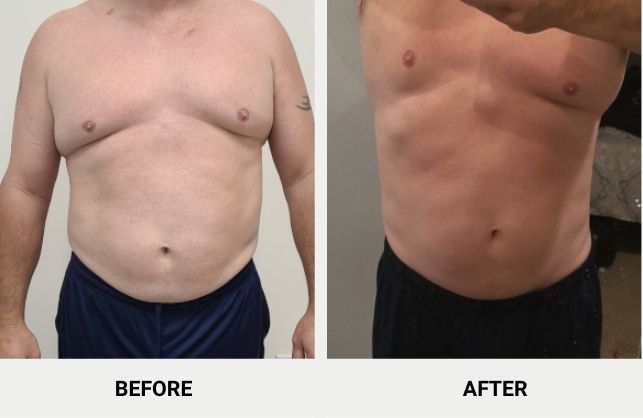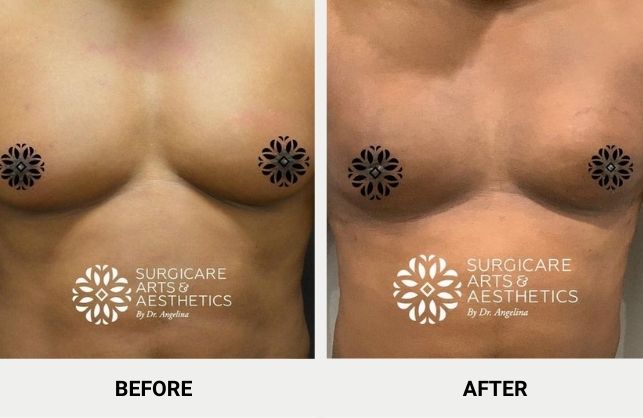One of the biggest concerns men have regarding gynecomastia surgery is the resulting scarring. I hear questions such as, “What kind of scar will result from gynecomastia surgery? How can gynecomastia surgery scars be less noticeable? Does scarless gynecomastia surgery exist?” Today we will discuss the types of gynecomastia scars that are possible, how they differ, why scars can vary in quality, what steps can be taken to help scars heal so they are less noticeable, and if you can avoid scars altogether!
What Causes Scarring During Gynecomastia Treatment?
The objective of gynecomastia treatment is to create a more contoured and masculine-looking chest Depending on the cause and extent of the gynecomastia, this may involve one or all of the following:
- Removing excess fat using liposuction
- Surgically excising any excess glandular breast tissue
- Eliminating excess skin
The resulting scars from these treatments can range from about 4mm to several inches long. The scars from liposuction procedures are usually very small because the incision made only has to be the size of the special tool (cannula) used during the procedure. These scars are usually located below and under the areola.
Some men require the removal of glandular breast tissue requiring an incision that runs around the areola to allow the surgeon to cut out the unwanted tissue. The scar is normally in a semi-circle shape on the edge of the areola.
Removing excess skin normally causes the longest scars that will vary in size and location depending on how much skin must be excised.
What Factors Influence Gynecomastia Surgery Scars?
Scars from gynecomastia surgery are influenced by the same conditions as any other type of scar. These conditional include:
- The way the wound was created – a surgical wound made by a scalpel is considered a clean wound and normally will heal the nicest. a wound caused by an injury normally leaves a scar that looks worse. An injury will normally include bacteria that has been introduced into the wound and tissue that has been traumatized.
- The manner in which the wound is closed – cosmetic surgeons are trained how to manage wounds in a way that results in the least amount of scarring. Scars can be influenced by the type of material used for the stitches, and the way the stitches are placed in relation to the orientation of the incision. Cosmetic surgeons often get called in to assist other doctors to manage wound care when reducing visible scarring is important.
- Genetics – unfortunately, some patients just tend to get bad scars and there is no fighting genetics. If you tend to scar badly, you will want to pay extra attention to do all you can to mitigate scarring after gynecomastia surgery.
How To Minimize Scars From Gynecomastia Surgery
The patient has an influence in reducing the appearance of scars post-surgery. Treating scars from gynecomastia surgery may include:
- General lifestyle choices – eating a healthy diet, drinking plenty of water, abstaining from smoking, avoiding excessive alcohol intake, and getting an adequate amount of rest will all play a part in how fast and how well your body heals.
- Wound care – keeping the incision site clean and following the instructions provided by the cosmetic surgeon on how to care for their wounds.
- Sun protection – healing scars and sun exposure are a bad combination and cause scars to be more visible and darker. Use a good sunscreen with an SPF of at least 30+ or avoid sun exposure on your healing scars.
- Topical creams and solutions – both over-the-counter and prescription topical solutions can help fade or reduce scarring if applied while the incision site is healing. The cosmetic surgeon can recommend the best solutions for you.
- Silicone sheets & gel – silicone is available in different forms from liquid-type gel, to self-adhesive strips and even a travel-size stick. It has been used for years and is known to be an effective way to help reduce visible scars.
- Scar massage after gynecomastia surgery – occasionally, scarring will cause raised areas under the skin after gynecomastia surgery and doctors often recommend massaging the area using a special technique to mitigate it.
- Vitamins & natural treatments to reduce scarring – both Vitamin E and Aloe provide hydration and help reduce inflammation which can help flatten forming scars. The antioxidant benefits of green tea and onion extracts help with the formation of new collagen and are often key ingredients in scar treatment creams.
Med Spa Solutions for Treating Healed Scars After Gynecomastia
After nature has taken its course and your scars are significantly healed (about 12 months). Some cosmetic treatments that are available at a medical SPA may be beneficial in lightening or reducing their appearance. These treatments include:
- Laser resurfacing;
- Light-based treatments;
- Microneedling.
Scarring After Gynecomastia Surgery
The scarring that results from gynecomastia surgery will be commensurate with how extensive the surgery is. For a patient who has a large amount of glandular breast tissue or has lost a significant amount of weight, with a large amount of loose skin to remove, larger incisions are inevitable. A skilled surgeon will do all possible to conceal the incisions to make the scars less visible.
Men who are suffering from gynecomastia are often inhibited in social situations that require them to take off their shirts. The condition causes embarrassment and a lack of self-confidence.
Most men report that they would rather have a few scars on a chest that looks masculine and naturally contoured as opposed to the way their chest looked before surgery.
Is Scarless Gynecomastia Surgery Possible?
True gynecomastia usually requires surgery to excise glandular breast tissue from a man’s chest. Each patient experiences scarring uniquely and preventing any scarring is virtually impossible. One of the best ways to prevent significant scarring is to choose a board-certified, highly-qualified cosmetic surgeon who has expertise in gynecomastia surgery. You can ask the surgeon to show you some examples of their work including before and after pictures of gynecomastia surgery.
In some cases, men are experiencing “fatty gynecomastia” which is the appearance of breast tissue but it is only fat. This fat can usually be removed through liposuction and minimal loose skin can be tightened using a cosmetic treatment such as BodytTite or PHYSIQ which are both non-invasive in-office procedures that can enhance the contours of a male chest.









